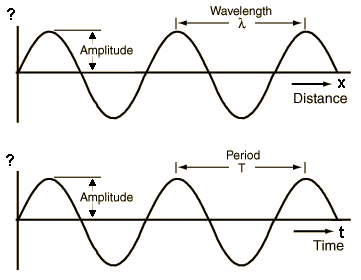Type and Property of Wave

1.How to describe a wave
- Wavelength λ
unit:meter m
Definition:Distance between two adjacent wavefronts OR Distance between two adjacent points which are oscillating in phase
- Frequency f
unit:Hertz Hz
Definition:Number of oscillation completed per unit time
- Wave speed v
unit:meter/second m/s
- Period T
unit:second s
Definition:Time taken for a vibrating particle to complete one oscillation
- Amplitude A
Definition:Maximum displacement of a vibrating particle from equilibrium position
- Intensity I
Definition:The intensity of a wave at a point P is the amount of energy arriving at P per unit area per unit time
Equation:I=Power/Area
In a wave,the intensity is proportional to amplitude squared
Equation:I ∝ A²
- Phase Difference
Definition:The difference of phase angle of two vibrating particles.
There are two different types of graphs which is used to describe waves
- Displacement-distance graph(D-d graph)
- Displacement-time graph(D-t graph)
Here is an example

-
Then,I am going to explain and talk about the relation between the above items.
1.1 Wave Equation
wave equation is the basic of the calculation in this topic.We can usually see it in both structured question and multiple choice question so that it is critical to understand and remember it.
Equation:v=λf
T=1/f , f=1/T
To derive the equation:
velocity = Distance moved/Time taken = wavelength/period = λ/T = λf
Therefore , we can derive that----
λ=v/f
f=v/λ
1.2 Phase
phase is a term to describe which position you are in a cycle
phase difference = ∆x/x ✖ 360° = ∆t/t ✖ 360°
path difference:The difference of distance between two sources getting the point.
path difference = ∆x
The special statements of phase difference
- In phase: No phase difference
- out of phase/anti-phase :phase difference = 180°
To describe the phase difference in a graph

The phase difference between them is determined by the angle between their wave cycles
1.3 Wave Intensity
- Definition:The intensity of a wave at a point P is the amount of energy arriving at P per unit area per unit time
The whole shape of wave(motion pattern)is moving on and energy is transferred forwards.
*Particles will not be transferred
Intensity = Power/Area
I=P/A unit = W/m²
Intensity is proportional to (Amplitude)²
I ∝ Α²
2.Determination of the movement of particle
To determine the movement of a particle in transverse wave, we can sketch another wave in the wave direction.
- For example

9702/12/M/J/22
T = 1/f = 1/0.5 = 2
Because it is a d-d graph and particles will not be transferred,the answer should come from option A or option B.
Draw another anti-phase wave which is in front of it.
Answer:B
3. Types of Wave
- Whether or not a wave transmits energy is one way we can distinguish the type of wave(Progressive wave and Stationary wave)
3.1 Progressive Wave
wave which transfer energy as a result of vibration.
- Due to the different directions of oscillation,the progressive waves can be divided into two types:transverse wave and longitudinal wave
-
3.1.1 Transverse wave
Definition: Displacement of particles perpedicular to the direction of energy propagation
E.G. Electromagnetic Wave,Ripple, Rope…
-
3.1.2 Longitudinal wave
Definition: Oscillations of particles parallel to direction of propagation of energy
E.G. Sound
3.2 Stationary Wave
It is clear that the wave profile is not travelling along the length of the spling.
The stationary wave is an quite important topic,so we'll talk about them in more detail in the next item.
